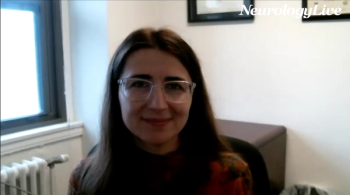
Treatment Options for a Patient With RRMS and Psoriasis
Expert neurologists discuss treatment options for a patient with comorbid autoimmune diseases, relapsing/remitting multiple sclerosis, and psoriasis.
Episodes in this series

Ahmed Zayed Obeidat MD, PhD: I’m going to tell you what happened in this case. Despite switching this patient to a different DMT [disease-modifying therapy], her symptoms continued to worsen. She developed psoriasis, which led to a decrease of her quality of life. Now she has another autoimmune disease that’s closely related to MS [multiple sclerosis]. The prior use of B-cell-depleting therapy may have something to do with it. In her most recent appointment with her neurologist, she discussed trying a new DMT that works differently from her current medication. They discussed the management of her psoriasis.
That’s where you have 2 different diseases. Both are autoimmune, and you’re trying to select 1 medication for both or you’re trying to select 2 medications: 1 for MS and 1 for psoriasis. What would be some of the available treatment options for that patient? It’s a difficult question. Dr Dukkipati, any options you’d think about with this scenario?
Ravi Dukkipati, MD: This is a challenging scenario. Thankfully, it’s not 1 we face regularly. B-cell therapies, anti-CD20s in particular, can increase one’s risk for a disease such as psoriasis. Presumably, that’s what happened in this patient. In terms of monotherapy for both multiple sclerosis and psoriasis in this patient, I don’t believe there’s a single agent that would be able to effectively address both. Some data suggest that natalizumab in combination with secukinumab can be administered simultaneously, addressing very active MS but also psoriasis.Another option is cladribine because of the way it’s dosed. You have 10 days followed by nothing for a year. That would allow for a window for appropriate treatment for the psoriasis option.
Ahmed Zayed Obeidat MD, PhD: They have lots of very effective medications for psoriasis, like systemic medication. She can always do UVB [ultraviolet B] light and other topicals. But with systemic medications, we have several patients with a combination of MS and psoriasis. Their psoriasis is under control with the new agents also.
Ravi Dukkipati, MD: I would say natalizumab combined with 1 of the others or cladribine…
Ahmed Zayed Obeidat MD, PhD: Cladribine, then a space, and then they can add another agent. Dr Pardo, any other thoughts on this?
Gabriel Pardo, MD, FAAN: This is a very important topic because even though it’s not very common, we do see that. Patients are in need of another medication that affects the immune system for a different disease. We’d love to have a single agent to treat both. Are we lucky? Sometimes. There are some diseases that a single agent might be able to treat, especially anti-CD20s. They treat a lot of autoimmune diseases. If that’s acceptable for the other specialists treating the other disease and we have good control, then we’re in heaven. But sometimes that’s not the case, and we have the risk of compounding the potential effects, which implies a worsening in the safety profile of our agents.
I’m thinking along the same lines that you guys are thinking. We do have therapies, like alemtuzumab, that will give us a short pulse of treatment with a prolonged biological benefit. That will allow us to free up the patient to use any other type of neurological medicine down the road if it’s needed for the other diseases. That’s a decision that I’ve made with several patients if they have chronic uveitis that has been resistant to different treatments and is recurrent. They are going to escalate on their immunotherapies for those situations or any other immune condition. The decision process has been let’s use a short-course agent. You’ll be free of treatment regarding your MS and free to use whatever other agent is necessary without compromising safety.
Ahmed Zayed Obeidat MD, PhD: That’s convenient because we want to minimize the number of combined immunosuppressive agents at a certain time. These are great points. These are 2 challenging cases. We don’t get them frequently in clinic, but they’re good to think about. This also tells us that even though you can fail a highly effective therapy, you can still have more options. That’s more hopeful. These cases are built to give hope that there are options that we can use even if we fail a highly effective therapy and have another autoimmune disease.
We have patients with ulcerative colitis and MS, patients with Crohn disease and MS. That’s not uncommon. We see this in regular practice and we think, “What would be 1 agent to treat both? Sometimes we need both—2 agents or more—to treat them, and that’s fine as long as we’re able to mitigate the risks associated with the use of these agents.
Transcript edited for clarity
Newsletter
Keep your finger on the pulse of neurology—subscribe to NeurologyLive for expert interviews, new data, and breakthrough treatment updates.












































